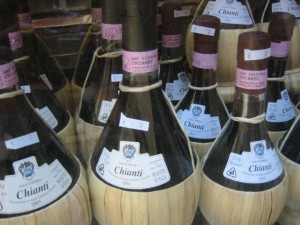
For many people, their first experience with Italian wine will be Chianti. It’s an experience that has the potential to be either very good or very bad and the reasons for this are intimately tied to the history of the wine.
Chianti became the first designated wine region in the world in 1716 when the Grand Duke of Tuscany, Cosimo III de’ Medici, issued an edict naming the land around the villages of Radda, Gaiole, and Castellina (with Greve added later) as the recognized producers of the wine. Today the boundaries of Chianti have expanded to cover almost 100 miles in length from north to south while the smaller area around the original villages is now known as Chianti Classico.
The modern definition of Chianti was formulated in 1872 by Barone Bettino Ricasoli and documented in a letter to Professor Cesare Studiati at the University of Pisa:
“… the wine receives most of its aroma from the Sangioveto (which is my particular aim) as well as a certain vigour in taste; the Canajuolo gives it a sweetness which tempers the harshness of the former without taking away any of its aroma, though it has an aroma all of its own; the Malvagia, which could probably be omitted for wines for laying down, tends to dilute the wine made from the first two grapes, but increases the taste and makes the wine lighter and more readily suitable for daily consumption… “
It is interesting to note that this description encompasses two styles of Chianti: a lighter, younger style for everyday drinking, and a richer, aged style. For a variety of reasons, it is the former that has been, until recently, dominant.
During the first half of the twentieth century, agriculture in much of central and northern Italy was based on a sharecropping system. Farmers who were making wine for their own consumption using their share of the grapes had little interest in (or surplus wealth to support) laying down bottles for aging, so they naturally turned towards the younger, everyday style. Many landowners were also focused on converting grapes to wine as quickly as possible and then selling it in bulk. Both would often manage the vineyards to produce as much fruit as possible, a bias reinforced by government-led replanting programs in the 1960s, and a choice that led to and acidic wines.
Further eroding the flavor of Barone Ricasoli’s original recipe was the replacement over time of the aromatic and flavorful Malvasia by the considerably less so Trebbiano. This was undoubtedly driven by Trebbiano’s prolific production, resistance to disease and rot, and adaptability to a wide range of soils. These are advantages which it also holds over Sangiovese, which may explain why larger percentages of white wine came to be used in Chianti blends.
The quantity over quality style became the official version of the wine when the Chianti DOC was created in 1967, and white wine grapes were required to be at least 10% of the blend, with up to 30% allowed. Using this formula, an ocean of tart, cheap wine was bottled and distributed far and wide in the straw-wrapped container all too aptly called a fiasco*.
However, even as the government was encouraging the production of bad wine, some Tuscan winemakers were focusing on excellence in winemaking. This movement is famous for giving rise to the ‘Super Tuscans’, but it also led to changes in the laws governing Chianti. In 1984, the minimum percentage of white wine grapes was reduced to 2% and blending up to 10% of “international” red wine varieties such as Merlot and Cabernet Sauvignon was authorized. Chianti and Chianti Classico were also upgraded to DOCG appellations, a change which reduced the maximum yield from the vineyards and led to the growing of more concentrated fruit.
The laws were changed again in 1996, eliminating the requirement for blending in white wine at all and upping the allowed portion of international grapes to 15%. Finally, in 2006, blending white wine was completely banned in the Chianti Classico region (though still permitted in other parts of Chianti), and the allowed portion of authorized international varieties was increased to 20%.

Bad Chianti still exists today, but there is also a lot of good. The most highly regarded region is Chianti Classico. Many of these wines, some will say the best, carry the gallo nero (black rooster) logo of the Chianti Classico growers association, Consorzio del Vino Classico Chianti. In the larger Chianti appellation, the wines of the Rufina sub-zone are generally considered the best, though good wines can come from anywhere in the region.
A full range of styles is available, from early drinking wines that, outside of the Classico region, incorporate white wines in the blend, to rich, age-worthy riservas that undergo extended maturation in wood. Finally, yes, there are those that only a generous person would categorize as, er, rustic. But, for the most part, Chiantis are still affordable enough that when you hit a bad one, you just open another bottle.
*Most etymologists believe that the English meaning of fiasco, ‘a complete failure’, is related to the Italian word for flask or bottle, but not because of bad Chianti. The origins of the English usage are unclear but apparently rooted in late 19th century Italian slang. Two good discussions of the subject are this entry on World Wide Words and Still in the Bottleneck, or, Chasing for the First Fiasco on the Oxford University Press blog.

One thought on “The Good, the Bad, and the Fiasco”